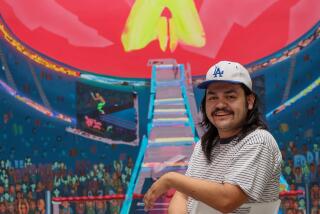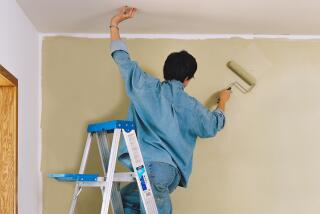New Product Aims to Wipe Out Graffiti : Miramar Firm’s Paint Allows Easy Cleaning of Defaced Surfaces : lean
- Share via
It smells like medicine and looks like sticky orange juice, but Gordon Wilder believes it is the powerful agent that will bring about the decline and fall of the age of graffiti.
Wilder is president of Southwest Coating Systems Inc. in Miramar. When Southwest introduced its anti-graffiti solvent and paint in 1981, no one believed it would work, he said. But it has been used to keep the Los Angeles Coliseum spotless during the Olympics and the San Diego Parks and Recreation Department has successfully tested it in public restrooms.
Wilder said the product is the answer to having to repaint areas defaced by graffiti. He dipped fingers into the liquid and smeared it on a piece of metal that was treated with the product, which is called the PK-2 Graffiti-proof Membrane, a polyurethane paint. The words “Gordon was here,” written with a permanent-ink marker, dissolved into the solvent on his fingers.
“And it’s mild on your hands,” Wilder said.
The process of graffiti-proofing a surface begins with a coat of paint that keeps existing graffiti stains from bleeding through. The application is followed by a clear coating of the anti-graffiti “membrane,” which hardens to near-glass consistency, Wilder said.
Graffiti that is applied to the treated surface can then be wiped off by the orange-colored remover.
Wilder claims the polyurethane paint, which comes in 18 colors, does not react to bleach, acid or gas and that ink, dye, lipstick and all types of paint can be easily removed. The product is guaranteed effective for five years.
The product is manufactured for Wilder, according to his specifications, by Los Angeles-based American Anti-Graffiti. The paint costs $48 to $56 per gallon and the remover is $23.50 and $29.50 per gallon.
Although Southwest Coating maintains a 25% annual profit margin, its total sales since 1981 are only $170,000.
The company, with five employees, has remained afloat primarily because Wilder’s Southwest Coating also operates an interior design supply business.
“Our greatest obstacle is getting people to believe that we’ve found the answer to the graffiti problem,” Wilder said.
Graffiti has been increasing rapidly during the past 10 years, according to Sgt. Hank Olais of the San Diego Police Department’s gang unit. “I see no immediate end to the problem. I predict it will get worse here and not a single area of the city is immune to graffiti.”
He said Wilder’s solution sounds plausible.
Ed Firkins, project officer of the San Diego Parks and Recreation Department, said he is a convert to the product.
After testing it on a heavily vandalized restroom in Balboa Park, the department recently decided to construct future restrooms with the anti-graffiti coatings in place, Firkins said.
Others who battle the graffiti problem maintain that the traditional paint and brush will have to do.
Ray Dobbs, director of the Neighborhood Improvement Council, said he has seen the product work, but the cost is beyond his budget.
“I’m not really skeptical,” Dobbs said. “But it’s too expensive.”
In February, more than 30 residents covered the graffiti in Memorial Park with paint donated by a local business, Dobbs said.
Wilder said he is working on developing a less expensive product without sacrificing the quality. Within six months, there will be a water-base membrane that homeowners will be able to purchase, he said.
Meanwhile, Wilder said he is launching his product in other parts of the country.
“I’ve written to Chicago Transit and New York Transit,” he said. “This will clean up the subways. No one wants to feel like they’re riding through mob central.”
More to Read
Sign up for Essential California
The most important California stories and recommendations in your inbox every morning.
You may occasionally receive promotional content from the Los Angeles Times.









